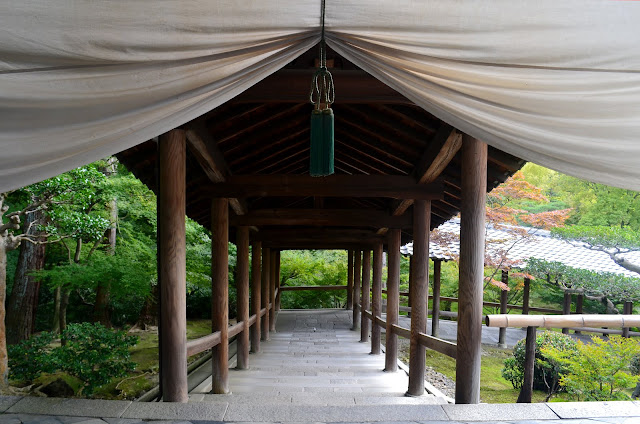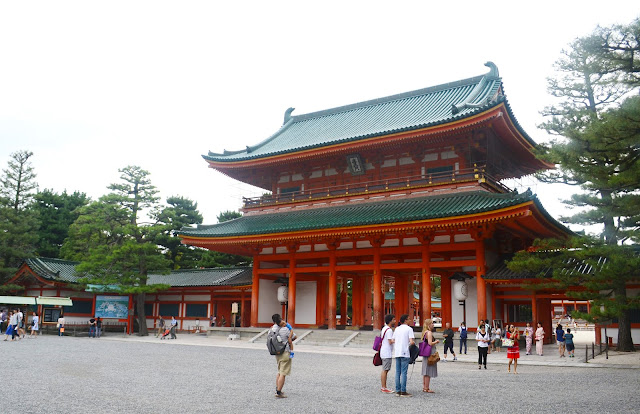I decided to head to a temple in Higashiyama-ku called Tōfuku-ji - one of the Five Great Zen Temples in Kyoto (the Kyoto Gozan). As with all the big temples in Kyoto, whole days could be spent taking in all the different sections and details. Unfortunately, most temples close around 4.30pm and I was coming after class so the whole day was not an option for me. I only had time to see the Northern area of the temple grounds, which included Tsutenkyo Bridge and Kaizando Hall. Since I was so late in the day it was fairly quiet, and I spend a nice hour or so wandering round pretending I was in a Studio Ghibli film:

I really loved the layout of Kaizando Hall, which you can see in the photos. They split the garden into two distinctive halves - one side is covered with lush green shrubs and the other side is that very simple dry landscape garden (white gravel raked to symbolise ripples in water). It creates a sense of harmony, or at least that's the vibe I was getting. Tsutenkyo bridge, which you can see in the last photo, is a very famous viewing point for the maple leaves in Autumn. They were only just starting to turn when I visited but it was still quite amazing.
Once Tōfuku-ji had closed, I headed about 5 minutes south to a very small and inconspicuous sub-temple called Kōmyō-in which I would never have found without the recommendation of a friend. Unfortunately this had also closed by the time I arrived, but they had left the side door open... it's nice that they don't need to bother locking doors since trespassing in Japan is so unlikely, but since I'd gone all that way I thought I'd take a *peek* into the garden. I hope I didn't offend the Gods there and I made a little offering so they would forgive my curiosity <3
This was the lovely view. Next time, when I'm less afraid of being shouted at in angry Japanese, I will get a much better look at the zen garden and see inside the building. Since it's so hidden away I think it'd be much more peaceful than some of the famous ones like Ryōan-ji.
So after that I was about ready to head home, but Fushimi-Inari was only about 15 minutes walk away and the taiyaki (fish-shaped filled pancakes) stand there was calling my name so I thought I'd made a quick visit...
Fushimi-Inari Taisha, a shrine consisting of thousands of Torii gates, is one of the most iconic places in Japan. I'll probably do a whole post about it at some point, but because of it's popularity it is quite unbearably busy even late in the day. To escape the mass of people walking through the gates, I took a mysterious side route through a bamboo forest. After about 30 minutes it started getting dark, but I had gone so far that I wanted to see what was at the end of the path. I found out far too late that actually I had chosen an alternative route to the top of Mountain Inari, which took me about 2 hours to reach the peak of. About 3/4 of the way up, in total darkness and with a bag full of school-stuff and heeled boots on, I had a serious think about my existence and a little cry. Not quite the quick detour I had planned for.
The peak of the mountain is actually quite underwhelming - the view is completely obscured by trees and it's just another shrine, which by that point you've seen thousands of. Feeling accomplished but a little bit pissed off I began my descent on the normal route and was finally met with the most beautiful view of Kyoto city by night. It was so late that only me and a few other stragglers were there, and because it was so unexpected it was a really magical thing to see. As usual, my poor camera skills haven't done it ANY justice but here's an idea:
After another long climb back down I was seriously ready for a good sleep. This has probably been one of my favourite days in Kyoto so far, and it was so great to be reminded that my own company is enough sometimes. Hopefully there will be many more adventures like this to come :))



















